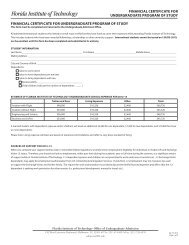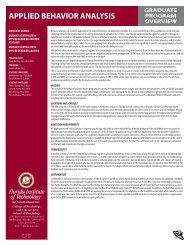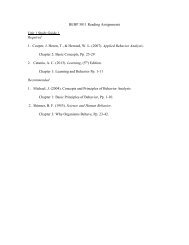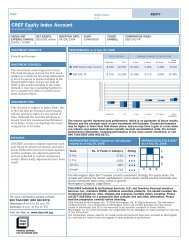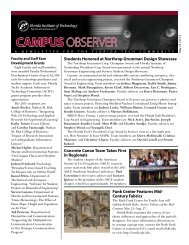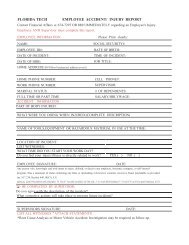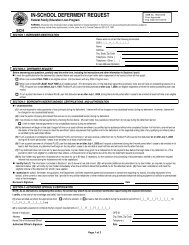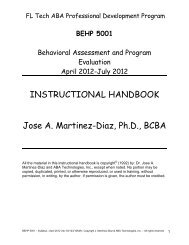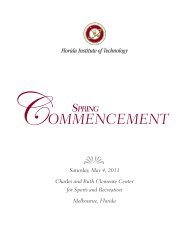2008–2009 - Florida Institute of Technology
2008–2009 - Florida Institute of Technology
2008–2009 - Florida Institute of Technology
Create successful ePaper yourself
Turn your PDF publications into a flip-book with our unique Google optimized e-Paper software.
lightning discharges, solar wind-magnetosphere coupling and<br />
global MHD simulations, inner magnetosphere dynamics and<br />
structure during magnetic storms and substorms, solar and heliospheric<br />
energetic particle observations, space environment and<br />
human space exploration, and physics and astronomy education<br />
research. Facilities currently available to our graduate students<br />
include:<br />
Astronomy and Astrophysics Laboratory: Astrophysicists and<br />
students work on a wide variety <strong>of</strong> topics, including the evolution<br />
<strong>of</strong> white dwarf stars, simulations <strong>of</strong> cataclysmic variable systems,<br />
astrophysical fluid dynamics, accretion phenomena, the physics<br />
and evolution <strong>of</strong> active galactic nuclei and their jets, cosmology,<br />
solar and stellar atmospheres, ultraviolet spectroscopy, and<br />
astronomical instrumentation. The astrophysics group includes<br />
pr<strong>of</strong>essors working in a variety <strong>of</strong> different wavebands from the<br />
radio to x-rays, including observations with the Hubble Space<br />
Telescope, Chandra X-ray Observatory, and the Far-Ultraviolet<br />
Spectroscopic Explorer satellite, as well as ground-based optical<br />
and radio observatories. Members <strong>of</strong> the group are involved in the<br />
development <strong>of</strong> instrumentation for the SuperNova Acceleration<br />
Probe (SNAP) and in the CanariCam Science Team, a guaranteed-time<br />
program on the 10.4m Gran Telescopio Canarias, the<br />
world’s largest optical telescope. Resources include Linux computers,<br />
astronomical data reduction packages including IRAF,<br />
AIPS and CIAO, the 0.9-m SARA telescope and the 0.8-m F.W.<br />
Olin Telescope.<br />
F.W. Olin 0.8-m Telescope: The 0.8-m automated telescope was<br />
installed in the ro<strong>of</strong>top dome <strong>of</strong> the F.W. Olin Physical Sciences<br />
Center in November 2007. Equipped with a large-format CCD<br />
imaging system and a spectrograph, it will be available for student<br />
and faculty projects as well as monthly public guest nights.<br />
The observatory will be accessible by conventional on-site means<br />
and remotely via the Internet.<br />
SARA 0.9-m Telescope at Kitt Peak National Observatory:<br />
<strong>Florida</strong> Tech is the administrative institution for the<br />
Southeastern Association for Research in Astronomy (SARA).<br />
See “Research” in the Institution Overview section <strong>of</strong> this catalog<br />
for more information.<br />
Geospace Physics Laboratory (GPL): This facility is a collection<br />
<strong>of</strong> four major laboratories that host all <strong>of</strong> <strong>Florida</strong> Tech’s<br />
space physicists, planetary scientists and their students’ research<br />
projects. These labs are outlined below (GPL–A-D). In a joint<br />
operation with UCLA <strong>of</strong> California, <strong>Florida</strong> Tech is hosting a 10site<br />
meridional array <strong>of</strong> magnetometers along the east coast <strong>of</strong> the<br />
United States (the MEASURE array) from <strong>Florida</strong> to southern<br />
Canada. The array observations, and particle and field measurements<br />
from various satellites are used for studying the geospace<br />
environment during magnetic storms and substorms. We also<br />
have joint operational custody (with the University <strong>of</strong> <strong>Florida</strong>)<br />
<strong>of</strong> the International Center for Lightning Research and Testing<br />
(ICLRT) that is located at Camp Blanding Army National Guard<br />
Base near Starke, <strong>Florida</strong>, where airspace can be controlled for<br />
rocket-triggering.<br />
Lightning and Instrument Development Lab (GPL-A): A series<br />
<strong>of</strong> recent theoretical breakthroughs and experimental detector<br />
development by our team working at both this lab and the ICLRT<br />
has led to the discovery <strong>of</strong> x-ray emission from lightning and<br />
its possible central role in understanding the lightning plasma<br />
processes. Exploring the implications <strong>of</strong> this discovery is one <strong>of</strong><br />
the main goals <strong>of</strong> this research lab. At the ICLRT, lightning is<br />
144 <strong>Florida</strong> Tech<br />
artificially triggered using small rockets trailing wires; in effect<br />
telling the lightning when and where to strike. This allows<br />
detailed observation and theoretical investigations to help us<br />
better understand how terrestrial (and planetary) lightning works<br />
and how to better protect our assets.<br />
Cosmic Rays and Space Weather Lab (GPL-B): This lab uses a<br />
network <strong>of</strong> workstations to study the energetic particle environment<br />
in the solar system. Some <strong>of</strong> the particles are cosmic rays<br />
from the galaxy, while some are produced by the sun during<br />
solar flares. By studying these particles, we try to understand the<br />
energetic phenomena in the galaxy or on the sun that affect the<br />
radiation environment at Earth. Gaining such understanding is<br />
one <strong>of</strong> our main goals to protect astronauts working space and<br />
the electronic components on satellites. In addition, analysis <strong>of</strong><br />
the COSPIN experiment on Ulysses and several other spacecraft<br />
datasets (Wind, SOHO, SAMPEX, ACE and RHESSI) in support<br />
<strong>of</strong> investigating the energetic particles environment with the<br />
solar system are conducted in this lab.<br />
Visualization and MHD Simulation Lab (GPL-C): This lab<br />
has state-<strong>of</strong>-the-art 3D visualization systems, video-processing<br />
workstations and shared memory multiprocessor systems for use<br />
in research and in the classroom. The systems use active and<br />
passive 3D displays to illustrate a variety <strong>of</strong> 3-dimensional topics.<br />
Some <strong>of</strong> the projects being pursued include classroom visuals<br />
such as 3D rendering <strong>of</strong> the Solar System, our Galaxy, and the<br />
Earth-Moon-Sun system. Scientific research in MHD modeling<br />
<strong>of</strong> space weather simulations is also conducted using 3D rendering<br />
as an analysis tool for studying the near-Earth space environment.<br />
Researchers are also investigating some cognitive science<br />
topics related to how the brain processes 3D imagery and how<br />
this may affect educational techniques in the physical sciences.<br />
Space Exploration Research Lab (GPL-D): This lab supports<br />
a research program focused on enabling sustained human space<br />
exploration and on the origin, distribution and future <strong>of</strong> life in<br />
the universe. The lab includes imaging systems, optics, calibration<br />
and test equipment, a large clean room, and other hardware<br />
used to support the development <strong>of</strong> space instrumentation. It has<br />
a high-performance computing system for modeling and simulation,<br />
and a ground control system to receive data and send commands<br />
to the International Space Station. Some <strong>of</strong> the labs activities<br />
are housed in the new Space Life Sciences Laboratory at the<br />
Kennedy Space Center, where atomic force and laser confocal<br />
fluorescence microscopes optimized for bioimaging, small-animal<br />
research hardware, and other equipment supports research into<br />
the hazards associated with long-term human exposure to the<br />
space environment, such as radiation damage, loss <strong>of</strong> bone mass,<br />
muscle atrophy and cardiovascular de-conditioning.<br />
Teaching and Research Assistantships<br />
The department <strong>of</strong>fers a number <strong>of</strong> teaching and research assistantships<br />
each year. Teaching assistants participate in laboratory<br />
instruction and/or assisting faculty in the preparation <strong>of</strong> teaching<br />
materials and grading. Research assistants work on research<br />
projects that are <strong>of</strong>ten related to their own master’s thesis or<br />
doctoral dissertation investigations. Both types <strong>of</strong> assistantships<br />
are awarded on a competitive basis, and provide graduate course<br />
fee remission and a stipend for living expenses. To increase the<br />
probability <strong>of</strong> receiving an assistantship, applicants are advised to<br />
apply as early as possible in the academic year prior to requested<br />
admission.




